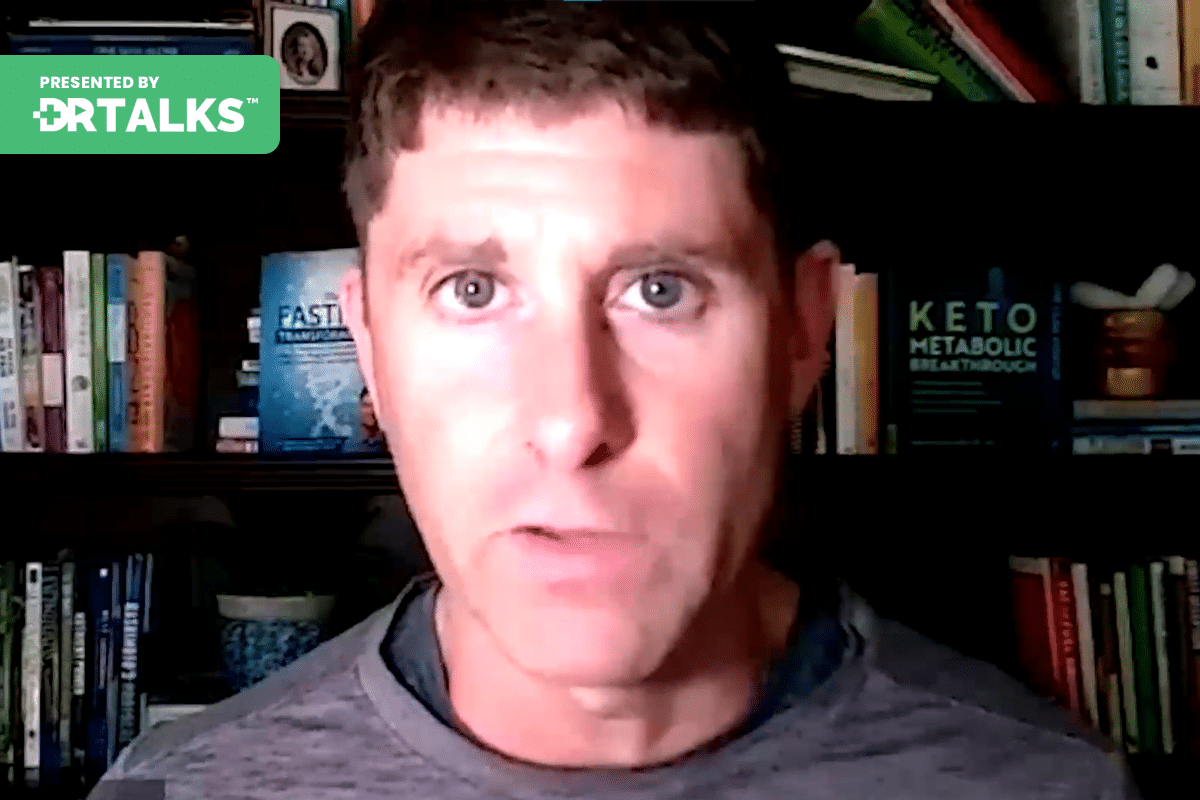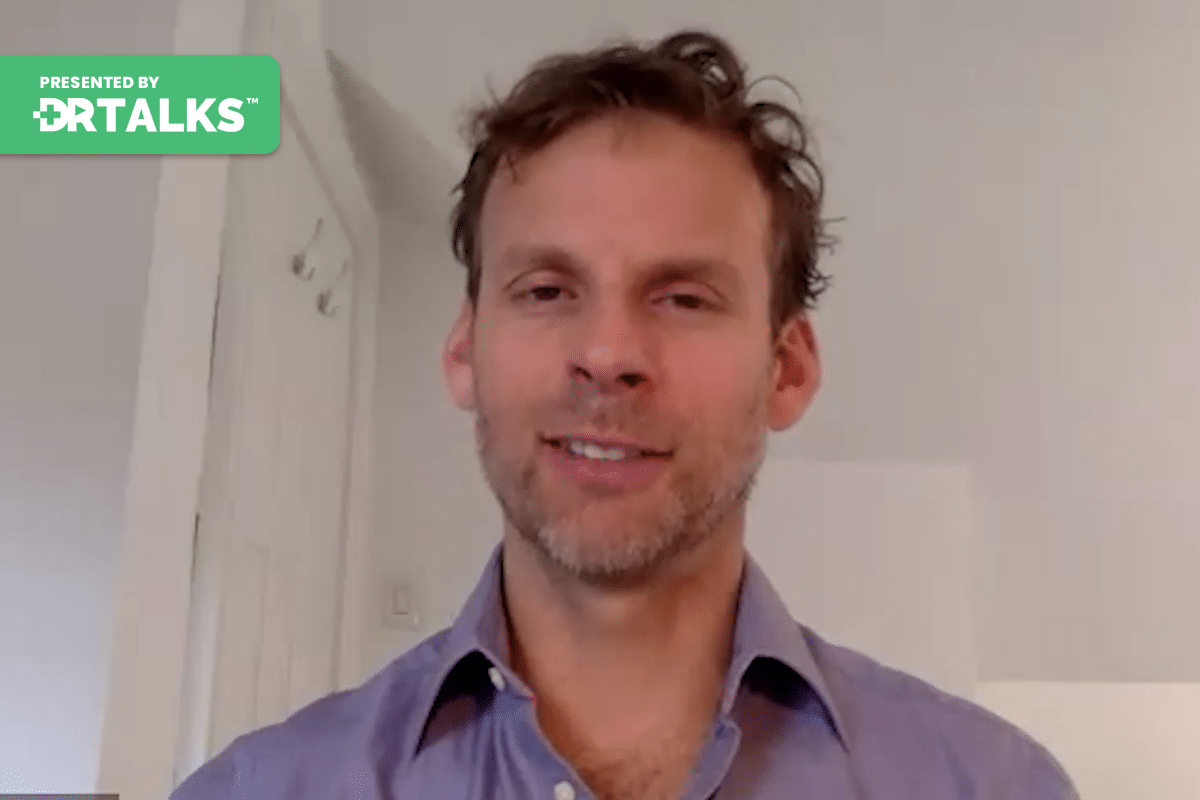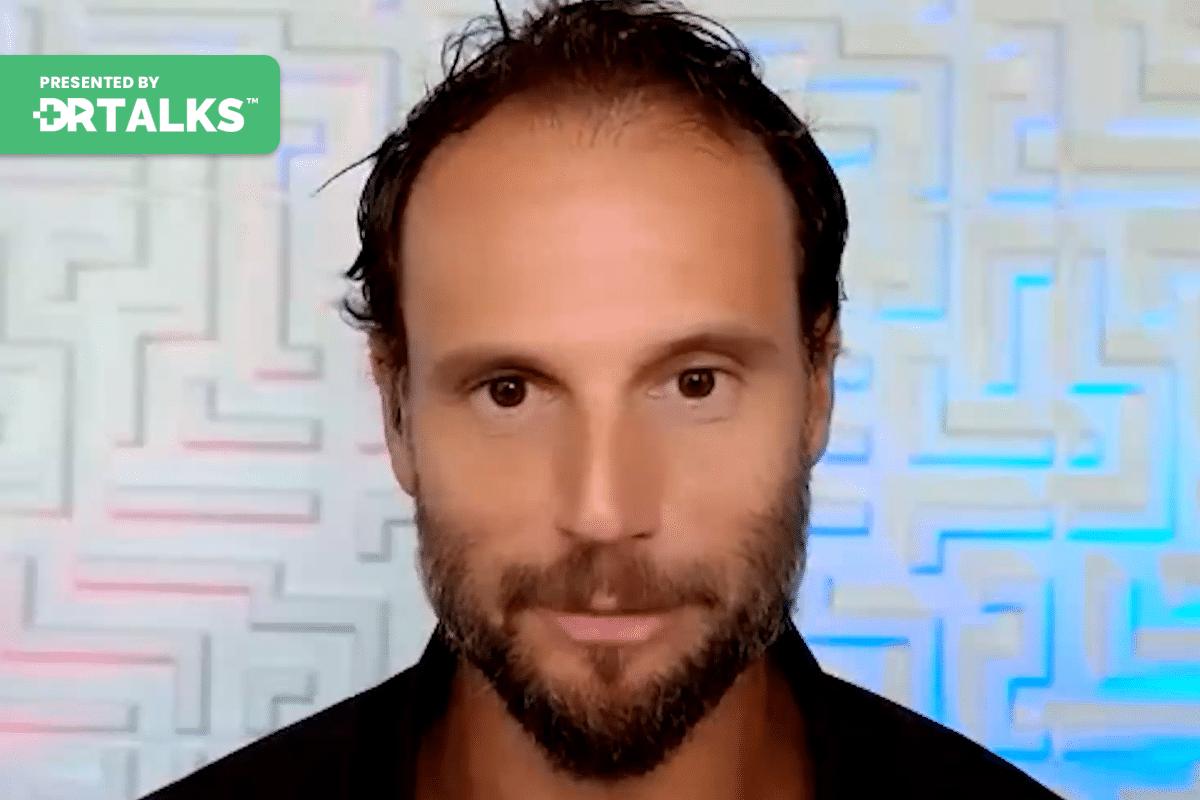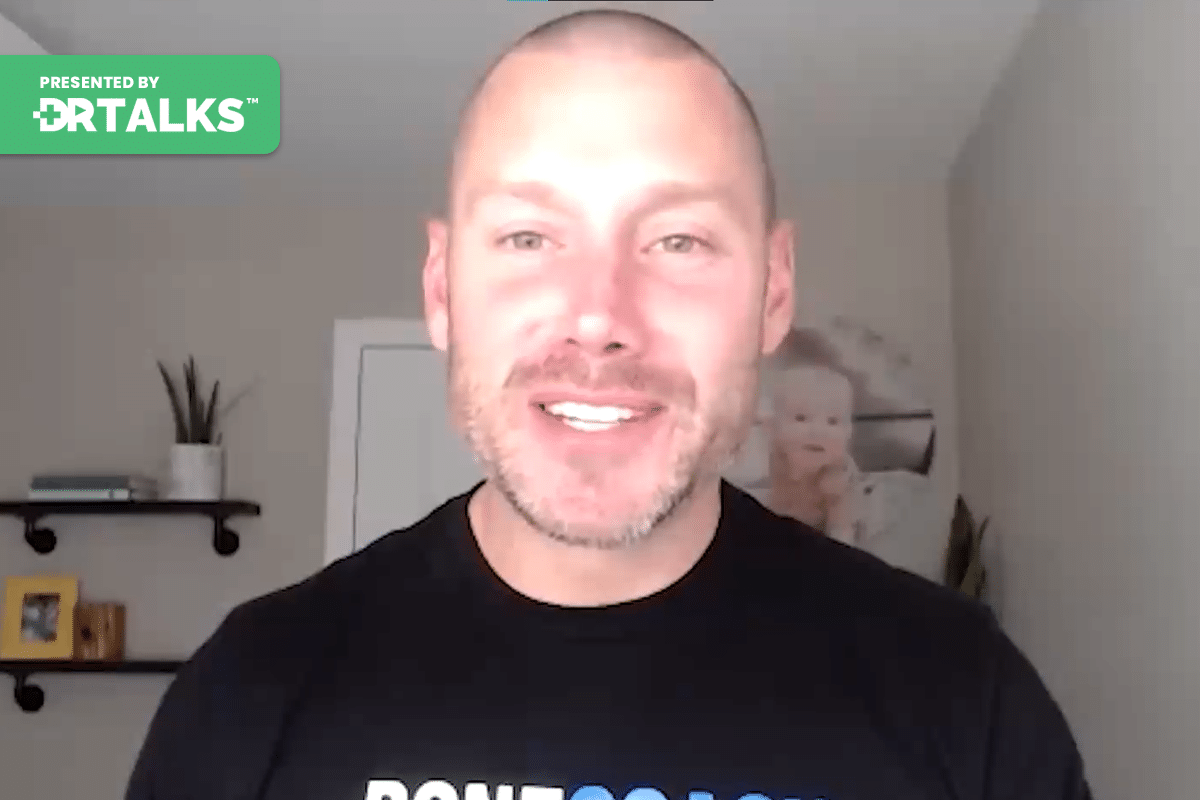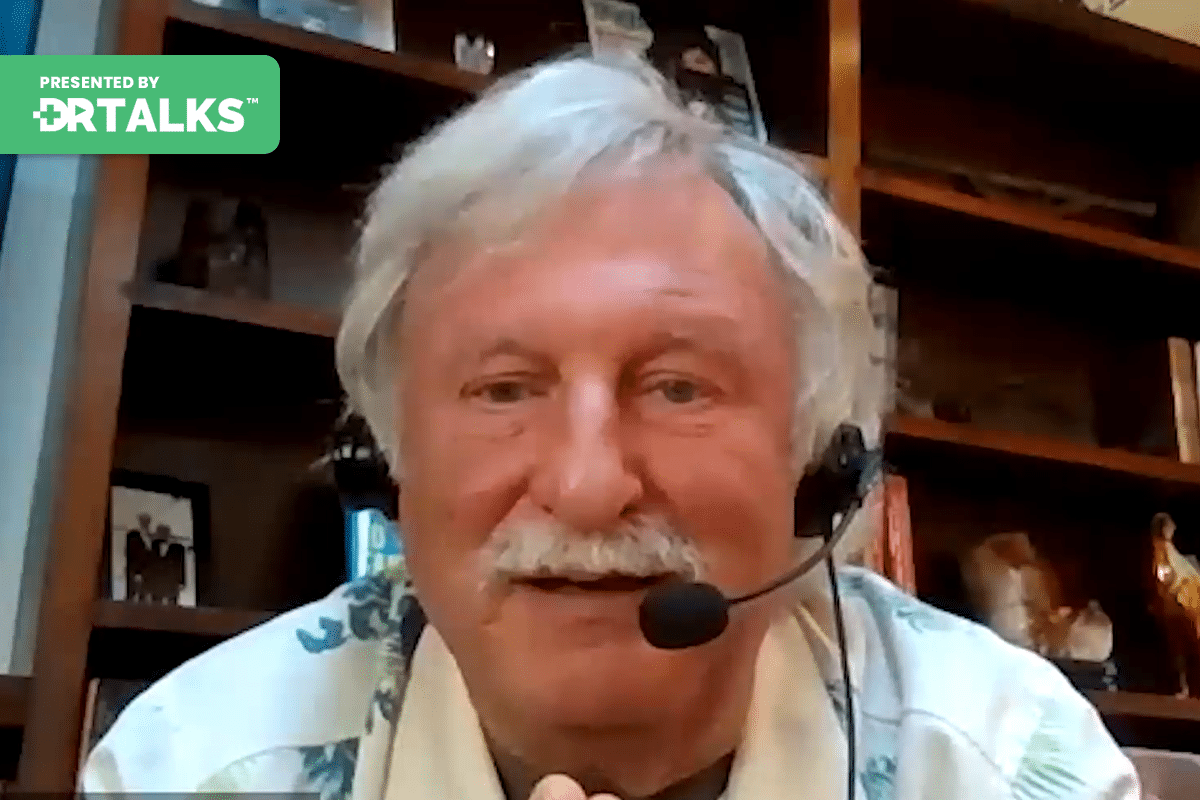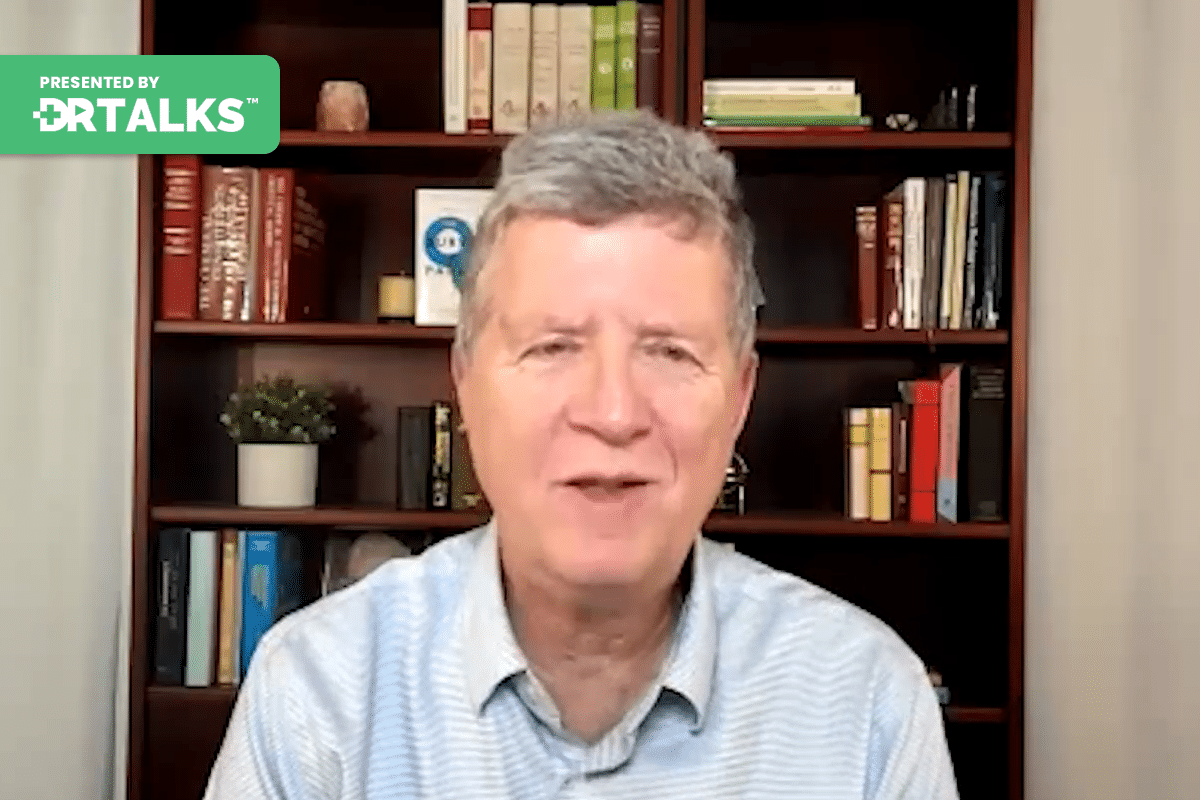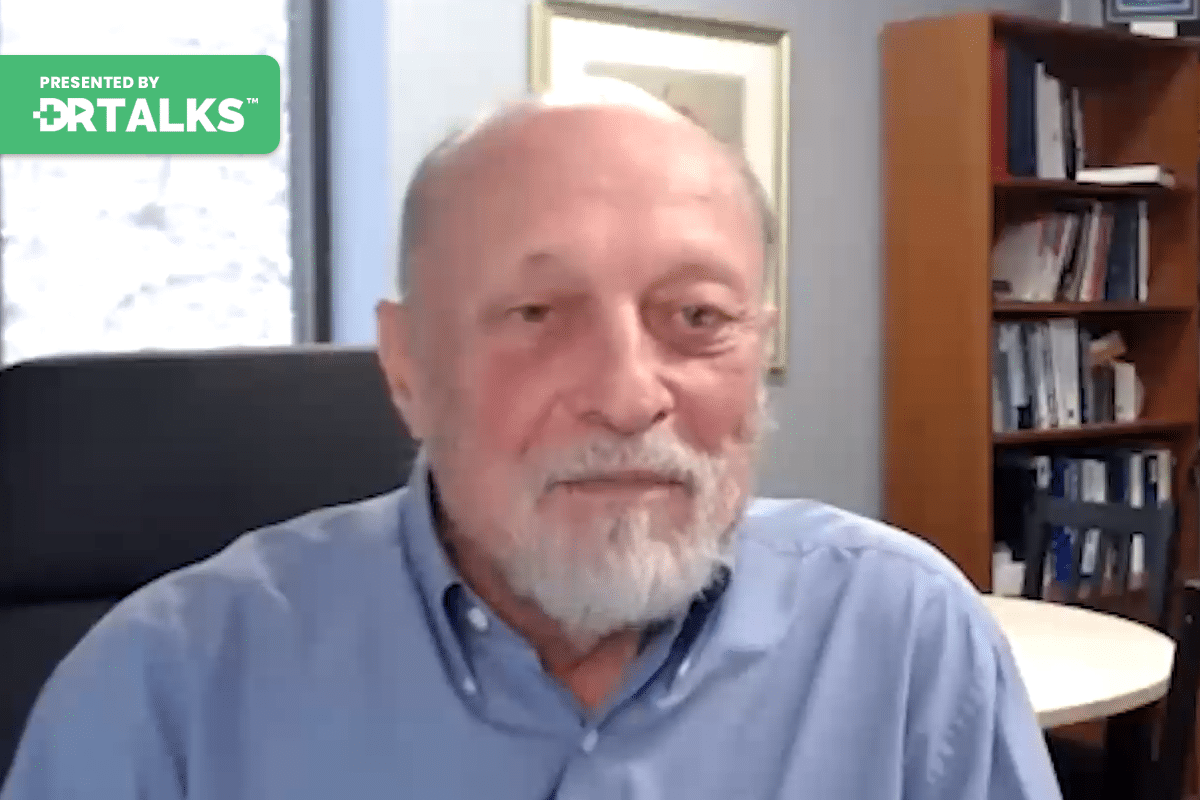Join the discussion below

Dr. Rodger Murphree is a chiropractic physician and board certified nutritional specialist. He is an internationally recognized fibromyalgia expert. His “Murphree Method,” a combination of functional and orthomolecular medicine, has helped thousands of patients get healthy and feel good again. He’s the author of 3 books for patients and doctors including... Read More

David Jockers, DNM, DC, MS is a doctor of natural medicine, functional nutritionist and corrective care chiropractor. He is the founder of Exodus Health Center in Kennesaw, Georgia and DrJockers.com, a website designed to empower people with science based solutions to improve their health. Read More
- The common triggers of inflammation?
- How do we reduce or eliminate inflammation triggers?
- Why periodic fasting, including intermittent fasting is so helpful for optimal health
Related Topics
Autoimmune Conditions, Autoimmune Response, Bacterial Toxins, Chemicals, Chronic Illness, Chronic Inflammation, Emotional Stress, Endotoxins, Fibromyalgia, Gut Inflammation, Gut Junction, Gut Permeability, Health Coaching, Immune Response, Inflammation, Inflammatory Pathways, Mental Stress, Micro Trauma, Pollutants, Resilience, Scar Tissue, Stress, Tolerance, Toxins, Undigested Food ParticlesRodger Murphree, DC, CNS
Hi. Welcome. I’m Dr. Rodger Murphree, and I’m the host of Freedom from Fibromyalgia. I’ve got Dr. David Jockers here. He’s a longtime friend, colleague and really kind of on the cutting edge, I think, of a lot of what we’re trying to accomplish in functional medicine. He’s a two time bestselling author and just shared a little bit about his bio is quite impressive, but I’m going to keep it short. David So we have a little time to talk, but Dr. David Jockers is a doctor of natural medicine Board, Savarkar practiced physician, master of science and a doctor of Natural Medicine, and he specializes in functional medicine. He’s the founder of Exodus Health Center in Kennesaw, Georgia. And DrJockers.com, a website designed to empower people with self science based solutions to improve their health. He’s gotten over 1 million monthly views on his website. And his podcast is fantastic and checked out his podcast. Please do so. We’ll talk a bit more about how to do that. And then he’s got two wonderful books that are out The Kino Metabolic Breakthrough and the Fasting Transformation. So David, welcome. Thanks for being a part of this summit. So glad to have you here.
David Jockers, DNM, DC, MS
Well, thanks so much, Rodger. Always great to connect with you and have these great, great conversations.
Rodger Murphree, DC, CNS
Well, so if I remove. All right, my favorite topic and then your favorite topic is inflammation. So between the two of us, we should be able to accomplish a lot on this conversation. What is inflammation? Let’s just keep it basic here for a minute. What is inflammation for sure?
David Jockers, DNM, DC, MS
Well, inflammation is an immune response, and it’s designed to help our body heal. And it’s also designed to help prevent against dying from a, you know, a systemic infection. In fact, we think about our ancestors more of our ancestors died from a systemic infection. So some sort of a, you know, bacteria or pathogen that got into the bloodstream, spread throughout the body, got into the lungs, gave people pneumonia, you know, gave them meningitis, got into the nervous system and ended up killing them. And so because of that, our body has adapted and created this inflammatory process that helps keep the pathogens from killing us quickly. And, you know, it’s lifesaving. It also helps to break down damaged tissue. Right when we have an injury, like if we sprain her ankle or whatever it is, the down downside. And, you know, really the downside of it is if we can’t turn the inflammation off, right?
So when it’s short term and acute, it’s amazing help save our life. But if it’s not turned off, if it’s not resolved, then it becomes chronic inflammation, which slowly over time wears down our joints, our organs, you know, whatever major area is being inflamed, our brain and causes chronic disease. So we love inflammation because of the survival advantages of it, but we have to keep it under control. We’ve got to address whatever the root cause of it is and dampen it down. Right. And I kind of look at it like a fire in a fireplace. Right. So in your home, cold winter day. Fire and fire and your fireplace, beautiful thing, right? Brings warmth to the home and creates a really nice environment. However, if you go and you dump gasoline on the fire now, it’s going to start to spread into the walls. Right. And it’s going to burn up the house. And so most people in our society, they’re living a lifestyle that’s pouring gasoline on the fire, on the inflammatory fire. And so the fire has now escaped from the fireplace, and it’s now burning down their walls. And that’s what we’ve got to get under control.
Rodger Murphree, DC, CNS
You know, I think a lot of people associate inflammation with trauma. So some type of physical exertion, something you can see, you can feel, you can. But it’s not just physical trauma. And certainly when you cut your finger, you see all the you know, the swelling and they see everything that’s happening, you know, with this with this, with this, with this infection that, you know, trying to prevent. So inflammation is a normal process of the body. Without it, we wouldn’t be able to survive. So it’s our defense mechanism. But as you said, it can get out of control. But there’s other things besides just physical trauma that creates this inflammation. Toxins, pollutants, chemicals that we take in through our diet or things that we breathe in the air that can initiate this reaction. And then, unfortunately, sometimes it never turns off this inflammatory reaction can just goes home, you know, to know it creates chronic inflammation and that makes us makes our immune system compromised so we’re more susceptible to maybe a more violent type or a more serious type of infection.
David Jockers, DNM, DC, MS
Yeah, absolutely. So we think about mental, emotional stress. So our ancestors, when they experience mental emotional stress, it may have been a life threatening circumstance. And so, like, you know, the body doesn’t know if you’re just driving down the road and somebody kind of cuts you off, right? Or somebody says something mean to you or if you are being ostracized from, you know, your community or from or if you’re being attacked, doesn’t really know the difference, going to respond the same way. And so when we are or when we encounter a mental, emotional stressor, the body starts to ramp up inflammatory pathways is and this is because again it wants to protect against any sort of flesh wound that could cause pathogens, bacteria, things like that, getting into the bloodstream.
And obviously killing us quickly. So we’ll start to drive up some of these inflammatory pathways and drive up inflammation in general. But at the same time, like you said, toxins and different things like that are all playing a role and we all have micro traumas. And so particularly when we think about it, you know, you may not have gotten a flesh wound, right? Like if we break our ankle or if we, you know, cut our you know, if we’re cutting something with a knife and we cut our finger or something along those lines. Right. It makes sense that our body is going to create that inflammatory response. It’s trying to protect it’s trying to break down scar tissue. It is trying to protect against the bacteria getting in. However, we could just do something like eat bad food. Like, for example, eat processed foods and those processed foods go into our gut and they actually trigger an inflammatory process in the gut. And that micro trauma, right, is not as big of a trauma as like spraining your ankle or cutting your finger open. However, it’s a micro trauma that now causes permeability in your gut, right? Starts to cause inflammatory processes and breakdown of the gut junction.
And we know that the gut is only one cell wall. Right. And so it’s one cell wall connected, particularly in the small intestine. And they’re connected by these tight junctions. The tight junctions, almost like little knitting or like cheesecloth in a sense that’s kind of holding it together. And then it’s got villi and that’s where the nutrients which, you know, should be broken down to a very, very small particles. And then they pass through the villa into the bloodstream. And now the body can deliver those nutrients to the cells of the body. And when we’re eating bad food or if we’re eating too much or overstretching our digestive system, then we start to have large undigested food particles and more inflammatory processes take place in the gut that opens up those gut junctions. And now we get large undigested proteins, we get bacteria, we get bacterial toxins. We call those endo toxins seeping into the bloodstream. And now the immune system becomes primed. It says, okay, wow, there’s a large number of bacteria or a large number of bacterial cell membranes. Right? Things like lipopolysaccharide. So we call those endotoxins. They’re now in the bloodstream and the body turns on the alarm and says, okay, we got it. We got to create a really strong immune response because, you know, we’re under attack here, right? There’s pathogens in our system. We’ve got to get these things under control. And so it does that for a period of time.
And, you know, if we do that, we, you know, say we have a bad meal, we overeat, and, you know, we don’t really respond well. We create that inflammation, we create that permeability. But then let’s say, you know, we fast overnight, you know, we get a good sleep that night. We heal up, right? The intestinal cells heal pretty quickly. Right. In fact, we turn over those intestinal cells every 3 to 5 days, you know, and then we get back into healthy lifestyle principles. We might be able to heal that up. Right. However, if let’s say we stay up late that night, let’s say maybe we drank some alcohol. You know, we got we encountered some stress. Whatever it was, didn’t sleep well. Then we had a bad it another bad meal. Now we’re kind of stacking all these inflammatory insults and we create more and more tearing and damage to that intestinal lining. And now we keep that inflammatory process elevated in the system. And now that inflammatory process is even more primed and creating more and more inflammation in. And it could even get to the point where the immune system adapts. And so it’s actually creating a lot of antibodies or an autoimmune response to different tissues of the body.
And when that happens now the immune system is has an even higher level of priming for inflammation. So then we have less tolerance, right? And all of us have a certain level of tolerance for toxins, for bad food, for stress, things like that. But the more and more that we overwhelm the gut lining and signal this inflammatory process, the lower our resilience and the lower our tolerance becomes. And now even, you know, things that may not have trigger. And a lot of people will say this, they’ll be like, you know what? Back in my twenties, I could eat whatever I wanted to. Now, in my forties, it’s like, you know, one bad night sleep and, you know, I’m done for two weeks or, you know, I eat a one bad meal and my joints hurt for two weeks. Right. Why? Because the resilience has gone down. The tolerance point has gone down, the immune system is more primed. And so all these little micro traumas add up.
Right. And ultimately, here’s the interesting thing to Rodger. And this is and particularly talking to somebody that is healthy, I know a lot of people listening to this have autoimmune conditions. They have fibromyalgia. They’re dealing with chronic, chronic issues. And, you know, and we’ll go into that as well. However, for somebody that’s fairly good health, maybe that hasn’t been diagnosed as a chronic illness and just wants to optimize their health, actually getting exposure to certain stressors to a, you know, a small degree, we call it horde medic stressors. And then having time to rest and recover properly is actually advantageous and actually builds higher tolerance and higher resilience. And so that’s actually in a survival advantage there. So it’s like we can’t avoid we don’t want to avoid these things 100%. We actually need stressors like exercise, for example, is actually a major stressor. If you looked if you did some level of intense exercise and then you took your blood did a blood draw right after that, your high sensitivity C-reactive protein, right? One of your major inflammatory compounds is skyrocketed, right? You got major inflammation in your system. You would think, oh my gosh, this person’s having a heart attack. But obviously and they may feel amazing, right? Their endorphins are up. They feel fantastic. Yet their blood work looks terrible because you took it right after the exercise. Exercise is catabolic.
It’s creates an inflammatory process. However, as long as you get the right nutrients, the right rest and recovery afterwards, your body is actually going to get stronger. It’s going to become more resilient. It’s going to be better at producing what we call endogenous antioxidant defense systems, which means these sort of defense systems that protect us from oxidative stress that we produce within our own intracellular glutathione, iron levels, catalase, you know, all the different intracellular antioxidants, superoxide dismutase, we get better at producing these natural antioxidants and we’re able to adapt and become more resilient to the stressors we face in life, which is really what all of us want to accomplish. So stress, micro traumas can add up and really create bad, big time problems. However, we actually need some level of stress and some level of micro traumas in our life in order to become stronger and more resilient. And so really the key is the balance and the recovery process.
Rodger Murphree, DC, CNS
So I think the two drivers of all chronic health conditions are stress and then inflammation. And I’m guilty and I admit this in an earlier book, my fibromyalgia book, where I talked about we don’t see inflammation environment. It’s not there because usually when we run tests, we don’t see an elevated said rate. CRP. And unless they have lupus, we don’t really see these inflammatory markers show up. And yet what we’ve learned over probably the last decade or so, certainly I have, is that this underlying inflammation is there for everybody. It’s a good thing. It’s a necessity. But for some people, that gets turned on, doesn’t get turned off. And we see with fibromyalgia there nervous system is on hyper alert. It’s over active. And because of that, you just described that so well. I have patients that I’m working with. They don’t tell me. Dr. Murphree, you know, up until two years ago, I could eat anything I wanted to. Now I’m down to all I can eat is rice and green beans or something.
Just crazy. They develop all these different conditions, these symptoms, these warning signs, which really is a sign that their body can’t handle any additional stressors or any different additional toxins because they’re in this reactive mode, this survival mode, which we’ve talked about here on the summit, and they can’t get out of it. They’re stuck. Now, you’ve just shared some ways that people can, you know, change that. Let’s talk a little bit more about diet. So I think really, you know, for fibromyalgia, the only way to overcome fibromyalgia is to get healthy. And that sounds I know sounds so simplistic. And part of that is you can’t get healthy without having a healthy diet. There’s just no way around that. So what are some of the things that you discuss in the macro world, you know, macro diet? And then we’ll look at fasting and fasting.
David Jockers, DNM, DC, MS
Yeah, for sure. So when it comes to diet, your first principle should always be you want to eat foods that have the most amount of nutrients and the least amount of toxins. Right. And that just kind of makes sense. Yeah. Like toxins obviously are going to cause problems. Nutrients are going to help your body heal and then so that’s kind of your first step and that’s going to steer you towards real food as opposed to processed and ultra processed foods. Real foods are going to have more key nutrients in them. And so that’s really where you want to steer towards. And then when you look at your macros, right by macros, we talk about carbohydrates, protein and fats, right? And as those are the main macronutrients we’re getting from our diet, we want to first off, every meal you should have at least 30 grams of high quality protein.
Why? Because protein helps create satiety, meaning you feel satiated. It’s really important for rebuilding lean body tissue. It’s very important for blood sugar and insulin stabilization. So you don’t get blood sugar imbalances which create inflammation. You don’t you don’t secrete too much insulin, which will also cause fat storage and prone fire will drive up pro-inflammatory pathways. So we want to get at least 30 grams of protein if you know, most of the listeners here probably aren’t. But if you are like an athlete, something like that, you probably want a lot more. I like when I eat a meal, I’m usually getting 50 or 60 grams of protein, but you want to get at least 30 grams. And then when it comes to fats, you want to get roughly around 20 to 30 or so grams of healthy fats and other healthy fats that you want are going to be from things like grass fed or pasture raised animal products. So like grass fed butter, for example, extra virgin, fresh pressed, high polyphenol olive oil, extra virgin olive oil, avocados or avocado oil would be a good or a good fat as well. And then things like coconut oil or coconut milk, something along those lines, right. Eggs, you know, pasteurized eggs are really good sources of healthy fats.
Obviously, if you have like a sensitivity food sensitivity allergy to something like that, you avoid it. But there’s other alternatives, you know, that you go for. Yeah. So you’re looking to get these healthy fats in your meals and then you want a lot of colors, right? So colors, colorful plants, what gives them colors are things called polyphenols? Right. Polyphenols are amazing for your gut lining. They’re amazing for your microbiome. They have antioxidants in them. So and then they taste good and they smell good and they provide a lot of variety, which helps with the overall diversity of your gut microbiome. So that’s really what you’re looking for. Lots of colors. Make sure you’re really locked in on how much protein you’re consuming and healthy fats. Some people do well on, you know, a little bit more fat. They feel more satiated. Some people can’t handle a whole lot of fat. Maybe they’ve got a sluggish bile flow. Are, you know, from there from their liver and gallbladder or maybe they don’t even have a gallbladder. So they might need more like 15 to 20 grams of fat in a meal. But if you get your protein, your healthy fats, and then you’re consuming these colorful, high fibrous fruits and vegetables, if you do that, you’re going to feel very satiated. You’re going to have blood sugar, stability, and you’re going to feel really, really good between meals and you’re going to be able to go longer periods of time without eating.
And that’s really key, because when you’re able to go longer periods of time, let’s say 4 hours between meals without needing to consume food and keeping your blood sugar stable. And then overnight, let’s say you finish dinner at 7 p.m. and you’re able to go till, let’s say 9 a.m. the next day without actually needing to eat anything. Remember to give yourself 14, maybe even 16 or 18 hours overnight without eating. That allows your gut lining to start to heal and regenerate and rebuild. Right. And you start to break down your body starts to break down damaged mitochondria and mitochondria, produce all the energy in the cells and actually start to create new, healthy, more stress resilient mitochondria. And that’s one of the key foundations to improving your energy and your stress resilience in life. Right. So super key. We got to get the blood sugar stable. We do that with the macros. I talked about the kind of food, food principles I talked about. And then we start to kind of extend the time. We start to avoid snacking and extend the time between meals and gives our time to our body time to heal and repair itself.
Rodger Murphree, DC, CNS
Yeah, so there’s a lot in there that I wanted to dove into a little bit, so definitely, you know, it takes a lot of energy to digest food. I mean, it’s a lot of energy that and if you’re snacking all day, it really sabotages your body’s ability to focus on other things that need repair. We know fibromyalgia that typically you have less mitochondria than the normal person. The mitochondria that you have oftentimes are decoupled. They’re not working like they should. So anything you can do to boost your mitochondria function or increase the amount of energy a number that you have is really helpful. But I want, you know, for 22 years or whatever it is now, I’m specializing in fibromyalgia initially. I want to ask people, you know, is your foods that you eat, you feel like gives you a hard time, you know, gives you trouble? And years ago, no one really answer that question. I was always looking for this answer that I’m now getting across the board. Now, when I ask my patients, Is your food when you eat seems to give you more, more fatigue and more pain, more brain fog. So these symptoms we associate fibromyalgia and a lot of them now are realizing that sugar is something that really can create problems for they’ve never really thought about it. But now there’s been so much written about, spoken about this whole thing about the dangers of excess sugar and insulin resistance, creating inflammation, that people are now admitting that.
So I find that my patients really do better on a higher protein diet, higher fat diet, whether that’s a keto diet or paleo diet. Now part of that is and you kind of talked a little bit about this, is avoiding these grains that have a lot of omega six in there. If you get to it now, omega six is a central fatty acid. You need it. But if you get too much omega six compared to omega three, another central fatty acid, you throw off the balance and you can create a thing called arachidonic acid. And you can create a lot of inflammation. So one of the things I think is beneficial with, with the keto diet that you’re, you know, that you’re such an expert on and the paleo diet is not said avoid grains is you’re now starting to get a more balanced ratio and ideally be 1 to 1 omega three to Mega six. We see that people are carrying around a lot of inflammation that can be as high as 20, 20 times amount of omega six to omega three.
David Jockers, DNM, DC, MS
Yeah, for sure. And a big factor with that is the amount of seed oils people are consuming. So if you go and you go to like any store, you look at the condiments, even the healthier condiments, salad dressings, things like that. You’re going to see one of the some of the main ingredients being corn oil, soybean oil, safflower oil, cottonseed oil, peanut oil. These oils have a ton of omega six, right? Real high omega six. And they’re very fragile oils that go rancid really, really quickly. When you consume them, they’re really going to go rancid inside your body, create trans fats and drive up all the inflammatory pathways and do everything you can to avoid these seed oils. So that’s one of the key nutritional principles I always recommend. Get rid of sugars and grains, right? Number one. Number two, get rid of these bad fats, these seed oils. Canola oil would be another one of them.
Yeah. And then switch over to the healthy fats like I talked about, high polyphenol, fresh pressed, extra virgin olive oils, one of the best you can consume, grass fed butter or ghee, grass fed beef tallow or beef fat is a really, really good one as well. You also have coconut oil, like I mentioned, coconut milk, avocados. All right. All really good olives. You can consume olives as well. That’s where you should be getting your healthy fats as well as pasture raised, grass fed, animal products wild caught, fish consuming, things like that. That’s all key. And then you want to do as much as possible. You know, I’ve already been mentioning this term, but moving away from your conventional animal products and towards your grass fed, pasture raised animal products, wild caught fish. And the main reason for that, well, two main reasons. Number one is a fatty acid composition like you talked about, omega six. So when on a conventional feedlot, when cows are eating, you know, they’re feeding them grains, right? They’re fattening them up on grains because it’s cheaper and the cows will grow larger. Right. So they can get more meat. They get more pounds of meat from the animal. However, the cows get very sick eating that high grain diet.
They get insulin resistance themselves and their higher and omega six fats are lower in conjugated linoleic acid, which is really amazing for the metabolism in immune system. It’s a really powerful fat, conjugated linoleic acid that we get in our particularly our grass fed animal products. They’re lower in vitamin E, vitamin A, I mean, across the board, the nutrients are lower and the grain fed animal products are also typically consuming grains that have been sprayed with pesticides, herbicides. So the toxin load is much higher. So you’re getting lower nutrient dense meat with higher toxic load. So obviously the more that we can minimize that and then really get the nutrient dense animal products, the better off we’re going to be. And that’s just a great source of protein. And we need that protein again for blood sugar stability to help with tissue healing and repair. So critical. And if we can get the blood sugar stable and we can get the nutrients into our body that we need, that’s going to really drive up the healing process well.
Rodger Murphree, DC, CNS
So, you know, cows are not meant to eat corn or soy and you know, that’s just not a healthy thing. And when you’re pouring that into your body, all these omega six oils from the livestock that are being fed that that’s where you really change the ratio of omega mega threes to mega six. So that’s it’s you know, people talk about eating grass fed livestock. That’s really the big reason why. I mean, you really want to get those omega threes in your well, let’s talk about your.
David Jockers, DNM, DC, MS
Typical grain fed cattle is about 20 to 1 omega six to omega three, whereas your grass fed cattle, you know, if it’s 100% grass fed, it’s usually around 2 to 1. Maybe even 1 to 1.
Rodger Murphree, DC, CNS
Yeah, yeah, yeah. Now tell me some of the benefits of fasting. Now, you know, in fibromyalgia, you know, they’re probably the audience. You know, I can’t do this. I can’t. I can’t fast. But there’s steps and David lays this out in his books. It’s very well done. We’ve had these conversations before. I take a lot of what he shares in his books, and I’ve shared that with my patients over the last five or six years. And it is something that really anybody can do it. But there are little baby steps that allow you to be able to get there.
David Jockers, DNM, DC, MS
Yeah, for sure. Well, the first step is do what I just talked about. Get your protein right, your healthy fats, make the dietary changes. Second step is stop snacking, right? So eat three good quality meals, like I mentioned, with that protein level, that fat level, you know, the colorful vegetables, colorful fruits and vegetables do that. And just do three meals a day. Right. And if you’re able to do that and feel satiated in between the meals, then fantastic. Now we’re ready to kind of extend your fasting window. And I always recommend starting with roughly about 12 hours overnight. So you don’t want to eat before you go to bed. That’s actually one of the worst things you can do for your melatonin levels, your deep sleep and restorative rest. And so you want to consume your last meal roughly 3 to 4 hours before you go to bed. So let’s say, you know, finish dinner at, let’s say 7 p.m. and then you want to fast at least 7 a.m. the next morning. But I would recommend starting your day by drinking water or herbal tea. Drink at least 16 to 24 ounces of fluid before you even think about a meal and what happens there.
And a lot of people will say, well, when I wake up, I’m so hungry and there’s probably a few reasons for that. Number one is, you know, that it’s a condition response. So when you’re used to eating breakfast every morning at 7 a.m. and you usually eat this big bowl of oatmeal or whatever it is you’re telling your body, I should be hungry at this time every single day. And so it’s kind of a conditioned response. And you have this hormone called ghrelin that comes out of your stomach when your stomach when there’s nothing in your stomach, when it’s not distended. And it also comes out at periods of time when you’re used to eating food, right? So again, a condition response and it goes to the brain. It tells you that you’re hungry. So if you hydrate in the morning, if you drink water, which all of us are dehydrated when we first wake up because we’ve been breathing out water vapor all night long. So if we hydrate our body, well, we’re going to distend the stomach. We’re going to suppress the ghrelin release, and you’re not going to feel the hunger. And this happens all the time.
People start just drinking water and they notice, okay, my hunger went away and actually feel more energized. Right? They feel better. And you can even just take a little bit of salt if you want. I notice for some people they feel a lot better when they do a little bit of salt, good sea salt or Himalayan salt along with the water. And I really like warm beverages, like a warm lemon water or herbal tea, like warm dandelion tea or something along those lines. And the warmness of the water will actually help stimulate your vagus nerve, which will help activate peristalsis so you can move your bowels early in the day, which helps reduce the amount of endo toxins in your system and will help bring down inflammation in your body. So you always want to move your bowels. Your large intestine is most active between 6 a.m. and 9 a.m., so you want to make sure you get at least one good bowel movement between that time of day and warm beverages can really help with that. For some people, if you’re able to tolerate coffee, do okay with that. Black coffee is fine as long as you know it doesn’t increase cravings or drive up. If you don’t feel like it drives inflammation, make you feel jittery, that can be helpful.
Or do you want warm lump, warm lemon water, warm herbal teas. And that’s fantastic. So now you’re you’re you’re you’re starting to condense your eating window. So let’s say that allows you to go till nine or 10 a.m. before you feel hungry. Okay, then go ahead and eat and eat a good solid meal. Right. Like I talked about. And then give yourself 4 hours or so between before your next meal and then consume your next meal and then, you know, you know, try to kind of condense your eating window to, let’s say, 8 to 10 hours. All right. Somewhere in that timeframe. And now you’ve gotten kind of the first step when it comes to what we call intermittent fasting or time restricted feeding. And that’s going to help improve your blood sugar. It’s going to help improve your body’s ability to burn fat for fuel. Because when you don’t have fuel, like when you’re not continually eating, your body says, okay, well, I need to start to since I’m not getting any sort of anything that’s increasing my blood glucose, I need to actually break down sugar from my liver and from my muscles. So it will start to do that and then it will also start to break down fatty acids.
So you start to burn your own body fat this way because your insulin levels go down, right? Insulin is a hormone that helps with that, that takes sugar, puts it into the bloodstream, sorry, puts it into the cells, takes out of the bloodstream, puts it into cells, and it also stops our ability to burn fat when we fast, when we go longer period of time between meals and we also eat a blood sugar, stabilizing diet or insulin goes down once it gets down below a certain threshold. Now we start to burn fat for fuel. So now we’re burning our own body fat. And that’s key because fat, we used to think was just a storage form of energy. But actually fat is an endocrine organ. And the more fat we have, the more inflammatory compounds. So fat itself will actually release cytokines. Inflammatory cytokines. And so the more that we’re burning this fat, the less inflammatory mediators that our body is actually going to produce. And so now we’re burning our own body fat for fuel. And as we extend that fast, longer, right now, the body says, okay, well, I actually need some sort of extra energy source for my brain because the brain is very, very metabolically active and we can’t get fatty acids across the blood brain barrier.
And if our blood sugar is going down and we’re using up some of that stored blood sugar, the body will actually take fatty acids, convert them in these compounds called ketones in the liver, that ketones are water soluble molecules that can now they’re smaller than fatty acids. They can cross a blood brain barrier. They’re a great fuel source for our neurons in our nervous system. And they also are what we call epigenetic modules TAS So they actually modulate the way our genes express themselves. And so when it comes to inflammation, inflammation is a certain genetic expression and it’s an expression that our DNA makes when it feels like it’s in a environment that is in war, right? In a wartime physiology, it turns on this inflammatory genetic expression. When ketones are elevated, it tells the brain, okay, this is more of a peace time. You know, physiology, it’s a time of famine, it’s a time of healing and repair. And we actually need better mental faculties so we can go out and find food. And so it actually brings down inflammation in the brain and it turns on the mitochondrial reproduction and what we call so mitochondrial biogenesis.
We also call it there is another term called Mitophagy where we actually break down all damaged, dysfunctional mitochondria within every chronic disease, particularly fibromyalgia. We find these mitochondria that have been rusted and damaged from oxidative stress. Right. And so they are not functioning well. They’re not metabolically flexible. And by metabolically flexible, I mean their ability to burn sugar as well as fat or ketones for fuel, that’s really important. They need to be able to burn both. Most people, if they’re not living a healthy lifestyle and if you have a chronic, you know, a chronic inflammatory condition or something like fibromyalgia, you have a lot of mitochondria that are metabolically inflexible. Right. And they’re rusted up. You know, think about it like a browned apple right there. They’re old, they’re damaged or decayed. They’re they’re barely producing any energy, but they’re producing a whole lot of free radicals and metabolic waste. And we need to get rid of those. Right. And so we need to break those down. This is what the body does. And it takes the raw materials, anything that’s good. Like kind of like breaking down like an old car. It’s like, okay, well, the car actually had a good, you know, bumper or something really.
We’ll find whatever is good from it and we can reuse that. Right. And that’s kind of your are recycling or, you know, plastic or whatever it is. This is what the body actually does is very energy resourceful to actually break down an old damaged mitochondria and then turn it into a new, healthy, young, stressed, resilient mitochondria. And that’s what it wants to do. It just needs the right environment. The right environment is when the ketones start to elevate and insulin goes down, that triggers the physiology to start to go through this process of autophagy and mitophagy in the mitochondria. And that’s what happens. And the longer we extend that fast, so we go 16, 18, 20 or even 24 hours, right? A full day, the more and more of that sort of cellular renewing process that we’re getting. But you don’t do that overnight. Okay. Well, it could be very stressful, kind of like exercise. You know, exercise we know is very healthy. However, if you’re sedentary, if you’re inflamed and you go and you try to get a great workout in, it’s actually going to be counterproductive. Right? You want to start slowly build up your level of fitness, right? Maybe go for a walk to your mailbox and then go for a walk. You down the road to the stop sign. Right. And he sort to gradually build a level of fitness. What’s kind of same with fasting, we get the dietary principles right with our macros, getting the right nutrients and the right foods on board. We stop snacking, we stick to the three meals and then we slowly tighten up that eating window until we find a really sweet spot. And then we can do, we can play with it, right? We can do things like, okay, one day a week, I’m going to do a 20 to 24 hour fast. Right, which is going to really build that metabolic autophagy. And you’re going to eat a lot of, you know, a lot of tear down of those damaged mitochondria and rebuilding of the new healthy mitochondria. And so we want to do that right. But then we might need a cycle it with, you know, one day a week where we’re consuming extra calories, right, to tell the body, okay, we’re in a feast. We actually want to cycle through periods of feasting and periods of famine. So that way we get the right hormonal expression because feasting tells the body, okay, we’ve got nutrients on board so we can produce sex hormones, right? We don’t we’re not in a time of stress that’s bad for fertility.
So, you know, we’re not going to you know, if somebody is fasting, for example, like there’s something called female amenorrhea where these women are, you know, they’re there. They’re training, doing extensive training. Right. And then they may even be underage eating, right, not consuming enough food. And they lose their menstrual cycle and they get all different types of hormonal issues. They lose their hair, things like that. So fasting, it’s important to remember that’s a stressor on the body, just like exercise. And so just like with exercise, you’re not most people are not going to be able to work out every single day, particularly as they get older. They need rest days and recovery days in between. It’s kind of the same with fasting. We don’t want to press and compress that eating window to tight every single day. We want to do that periodically and then also have days where we’re consuming a really good amount of calories and telling the body, okay, food’s onboard, nutrients are on board, let’s produce the right amount of sex hormones, right amount of thyroid hormones and cycling through that. We call that feast or famine cycling. I talk a lot about that in my books, on my podcast, things like that and different strategies. You can do that. We’ve seen be very effective for people.
Rodger Murphree, DC, CNS
So, you know, as functional medicine practitioners, we’re always looking at what are the underlying causes of these symptoms, you know, fibromyalgia, we got all these symptoms. Fibromyalgia is just a name. We really want to know what’s causing the pain, what’s causing the fatigue, what’s causing the brain fog and we want to search out those things. It could be mold toxins. It could be Lyme, it could be an infection. It could be there’s numerous things that could be creating these symptoms. But a real game changer for my patients is going on an anti-inflammatory and if needed, a weight loss diet combined. Patients on my diet that need to lose weight, you know, they’ll lose half a pound a day. I have patients lose 20, 30, 40 over 100 pounds. And what tell me over and over again is by losing that weight, they have more energy because their metabolism goes up, their mental clarity improves, their sleep improves and their pains dramatically goes down because we’re getting rid of those inflammatory chemicals and toxins that are stored in these fat cells. I think that’s the beauty of what, you know, you teach in your work, your podcasts and in your books about the intermittent fasting in the keto diet. It’s a way really to get these toxins out of your body, and by doing that, it becomes addictive. Really, I think I’ve adopted the intermittent fasting lifestyle. I like the fast periodically as well. I always feel so much better doing it. And a few years ago when I was introducing that to my patients, they were I can’t do it. I can’t do it now what I see is with these baby steps and they start to do it begins to be they really enjoy it because they feel so much better.
David Jockers, DNM, DC, MS
Oh, 100%. Absolutely. And, you know, you realize fasting is something all of our ancestors have done. I always say it’s the most ancient, inexpensive and powerful healing strategy known to mankind, because it’s really built into our DNA, our genetics, our body knows exactly how to handle a time of famine. Right. And that’s why we exist here. As, you know, humanity, we’ve gone through a lot of famines and our body knows exactly what to do in our society. Today, we’re in the opposite where we’re in a period of time where most people are overfed but undernourished, right? Meaning that they have more than enough food on board and their insulin levels are sky high, but they’re actually nutrient deficient. And so how do we change that over while the innate intelligence of the body knows how to knows how to do this right. And the key is, again, starting to go undergo these little these small fasts, right? And compressing that eating window. And the body knows exactly how to adapt to that and become stronger and more stress resilient. Of course, you know, when we eat, we want to make sure we’re getting very high, nutrient dense foods into our system for the key nutrients that we do need.
Rodger Murphree, DC, CNS
Yeah. So when I encourage everybody, check out Dr. Crocker’s website, Dr. John Cars.com, his books are available on Amazon, available on his website and his podcast. Tell me a little bit about your podcast. Is that can they access that on your website? Right. They can see where to go to get.
David Jockers, DNM, DC, MS
Yeah, yeah, for sure. Yeah, you can see it there. You go to like Apple, iTunes, Spotify or wherever you listen to podcasts and just type in Dr. Jacob’s Functional Nutrition podcast.
Rodger Murphree, DC, CNS
Perfect. Great. David, as always, thank you so much. Wealth of information you just shared. I hope people will take this and from it don’t don’t overanalyze it. Just take the simple little steps of cleaning up your die. I mean, that’s the first thing you can do in your journey to feel better, to get healthy, and to stay that way. Just start to clean up your diet. Take some of the principles that he shared today. And I think you’re going to see just by doing that, you’re going to start creating the environment of actually feeling a little bit better and get some, you know, get some traction on the mountain of house. So thanks so much, Dave. Enjoyed spending time with you.
David Jockers, DNM, DC, MS
Thank you, Rodger. Appreciate you.
Downloads

